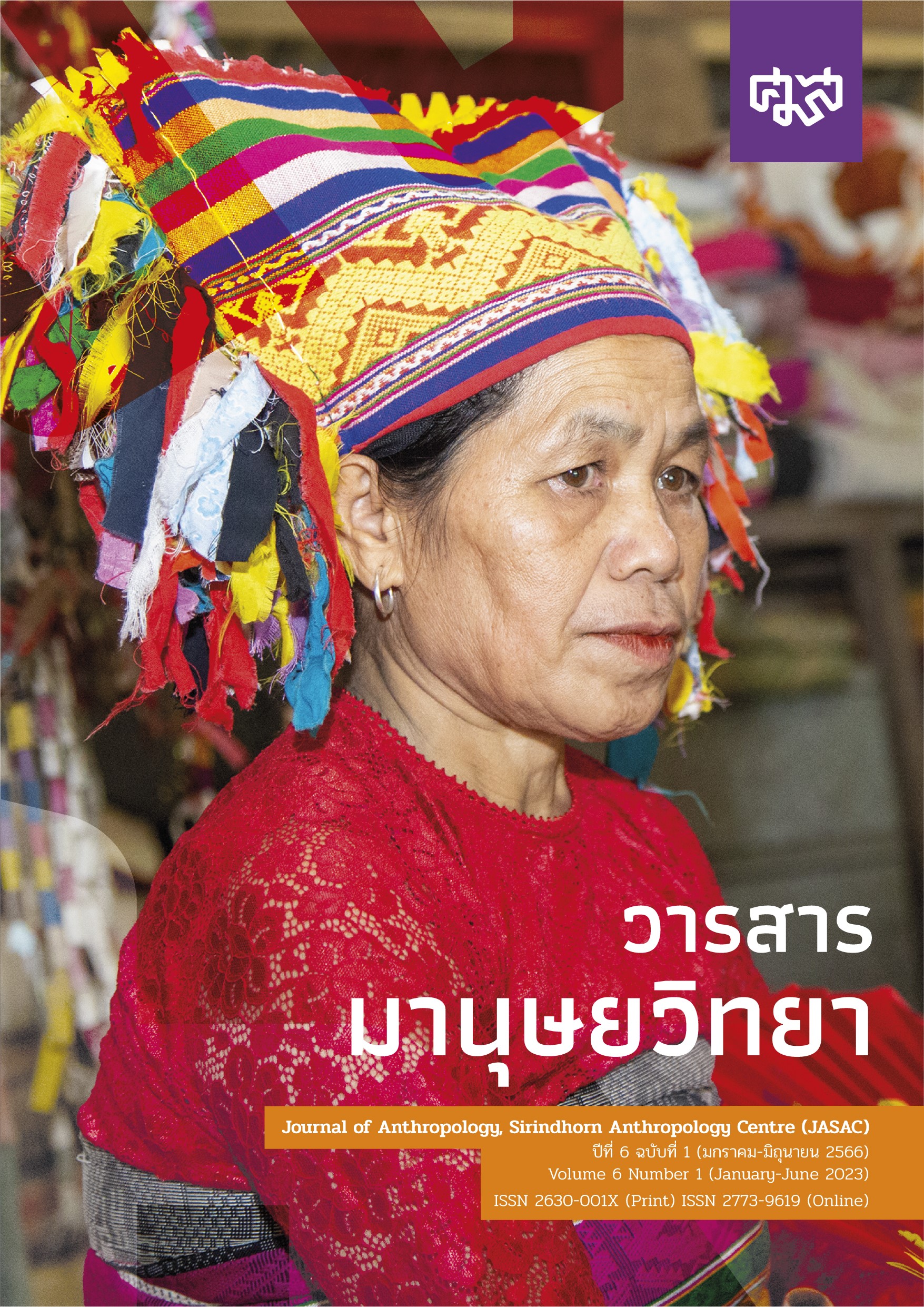เมื่อแม่มดพูด โครงสร้างของความรู้สึกในคติท้องถิ่นในพิธีจ๋าเจียงของคนไทในเวียดนาม ในบริบทของการแปลงทรัพยากรธรรมชาติให้เป็นสินค้า
Main Article Content
บทคัดย่อ
บนความย้อนแย้งระหว่างกฎหมายที่ดินในปี 1996 ที่ให้แต่ละครัวเรือน
ใช้ประโยชน์ ดูแลป่าเศรษฐกิจ และกฎหมายป่าไม้ในปี 1991 และ 2004
ที่ให้สิทธิแต่ละครัวเรือนและคอมมูนดูแลป่าสงวน ในด้านหนึ่ง กับอีกด้านหนึ่งคือการที่รัฐผลิตวาทกรรมการพัฒนาขอเปลี่ยนพื้นที่ป่าให้เป็นพื้นที่อุตสาหกรรมป่าไม้ ซึ่งได้มอบอำนาจในการจัดการป่าไปไว้ในมือของรัฐและทุนสิ่งนี้เป็นตัวอย่างที่แสดงให้เห็นนโยบายเศรษฐกิจของรัฐในการแปรรูปทรัพยากรไปเป็นสินค้า อย่างไรก็ดี วิถีทางที่ชุมชนท้องถิ่นจัดการกับทรัพยากรธรรมชาติ
Article Details

อนุญาตภายใต้เงื่อนไข Creative Commons Attribution-NonCommercial-NoDerivatives 4.0 International License.
ลิขสิทธิ์@ของวารสารมานุษยวิทยา
ศูนย์มานุษยวิทยาสิรินธร (องค์การมหาชน), กรุงเทพฯ, ประเทศไทย
ข้อมูลเพิ่มเติม:
https://creativecommons.org/licenses/by-nc-nd/4.0/
เอกสารอ้างอิง
กาญจนา แก้วเทพ. (2552). การสังเคราะห์องค์ความรู้เรื่องการใช้และการเสริมความเข้มแข็งแก่การสื่อสารเพื่อการพัฒนาชุมชน. กรุงเทพฯ: สํานักงานคณะกรรมการส่งเสริมวิทยาศาสตร์ วิจัยและนวัตกรรม.
กาญจนา แก้วเทพ. (2553). การสื่อสารในพิธีกรรม พิธีกรรมในการสื่อสาร. วารสารวิทยาการจัดการ มหาวิทยาลัยราชภัฏเชียงราย 5(1), 1-26.
ชิเกฮารุ ทานาเบ. (2555). การพรากความทรงจําในพิธีกรรม: กระบวนการรับรู้ในพิธีเข้าทรงในภาคเหนือของประเทศไทย (อภิญญา เฟื่องฟูสกุล,ผู้แปล). ใน ขวัญชีวัน บัวแดง และอภิญญา เฟื่องฟูสกุล (บก.), พิธีกรรมและปฏิบัติการในสังคมชาวนาภาคเหนือของประเทศไทย (น. 113-139). เชียงใหม่: ศูนย์ศึกษาชาติพันธุ์และการพัฒนา (ศูนย์ความเป็นเลิศ).
ฉวีวรรณ ประจวบเหมาะ, สิริพร สมบูรณ์บูรณะ และ พิเชฐ สายพันธ์. (2562). พิธีสวดภาณยักษ์ ความหมายและการเปลี่ยนแปลง. กรุงเทพฯ: ศูนย์มานุษยวิทยาสิรินธร (องค์การมหาชน).
ยศ สันตสมบัติ. (2559). ชายแดนกับความหลากหลายของระบบความเชื่อ: การช่วงชิงพื้นที่ศักดิ์สิทธิ์ และการครอบงําเชิงสัญลักษณ์. ใน ยศ สันตสมบัติ (บก.), ชายแดนกับความหลากหลายของระบบความเชื่อ: การช่วงชิงพื้นที่ศักดิ์สิทธิ์ และการครอบงําเชิงสัญลักษณ์ (น. 1-67). เชียงใหม่: ศูนย์ศึกษาความหลายหลายทางชีวภาพ และภูมิปัญญา ท้องถิ่นเพื่อการพัฒนาอย่างยั่งยืน คณะสังคมศาสตร์ มหาวิทยาลัย เชียงใหม่.
อัจฉริยา ชูวงศ์เลิศ. (2561). การสร้างพื้นที่ทางวัฒนธรรม สถานที่ และอัตลักษณ์ในการพัฒนาสังคมของคนไทภาคกลางตอนเหนือของเวียดนาม ในยุคก่อนระบบเศรษฐกิจการตลาด. พิษณุโลก: กองส่งเสริมศิลปวัฒนธรรม มหาวิทยาลัยนเรศวร.
อัจฉริยา ชูวงศ์เลิศ. (2564). การเมืองของการเซ่น (ผี) เมืองไทในเวียดนาม. กรุงเทพฯ: ศูนย์มานุษยวิทยาสิรินธร (องค์การมหาชน).
อัจฉริยา ชูวงศ์เลิศ. (2566). การสื่อสารในพิธีกรรมและอํานาจศีลธรรมของ แม่มดในสังคมการเมืองไทในเวียดนาม. วารสารศาสตร์, 16(1), 249-289.
อานันท์ กาญจนพันธุ์. (2555). เจ้าที่และผีปู่ย่า: พลวัตของความรู้ชาวบ้าน อำานาจ และตัวตนของคนท้องถิ่น. เชียงใหม่: ภาควิชาสังคมวิทยาและมานุษยวิทยา คณะสังคมศาสตร์ มหาวิทยาลัยเชียงใหม่.
อานันท์ กาญจนพันธุ์. (2564). บทนํา. ใน อานันท์ กาญจนพันธุ์ (บก.), เสียงที่ไม่ได้ยิน: อารมณ์และความหวังในพื้นที่ความรู้ (น. 1-34). เชียงใหม่: โครงการการสร้างพื้นที่ความรู้ในสังคมพหุวัฒนธรรมของกลุ่มคนที่กำลังก่อตัวขึ้นใหม่ในกระบวนการเปลี่ยนผ่านเข้าสู่สังคมสมัยใหม่และภาควิชาสังคมวิทยาและมานุษยวิทยา คณะสังคมศาสตร์ มหาวิทยาลัยเชียงใหม่.
แอนดรู วอล์คเกอร์. (2559). ชาวนาการเมือง: อํานาจในเศรษฐกิจชนบทสมัยใหม่ของไทย (จักรกริช สังขมณี, ผู้แปล). นนทบุรี: ฟ้าเดียวกัน.
Bacquet, S. (2019). Religious Symbols and the Intervention of the Law: Symbolic Functionality in Pluralist States. London and New York: Routledge.
BalocKaite, S. (2014). On Ideology, Language, and Identity: Language Politics in the Soviet and Post-Soviet Lihuania. Lang Policy, 13, 41-61.
Bauman, R. (1975). Verbal Art as Performance. American Anthropologist,77(2), 290-311.
Canestri, J. (2007). Language, Symbolization, and Psychosis: An Introduction. In G. Ambrosio, S. Argentieri, & J. Canestri (Eds.), Language, Symbolization, and Psychosis (pp. 1-17). London and New York: Routledge.
Evans, G. (1998). The Politics of Ritual and Remembrance: Laos Since 1975. Hawaii: University of Hawaii Press.
Gilbert, M. (2006). A Theory of Political Obligation: Membership, Commitment, and the Bonds of Society. Oxford: Clarendon Press.
Gottowik, V. (Ed.) (2010). Introduction. In V. Gottowik (Ed.), Dynamics of Religion in Southeast Asia (pp. 9-29). Amsterdam: Amsterdam University Press.
No, D. (1962). The Ethnography of Speaking. Anthropology and Human Behavior, 13(53), 11-74.
May, S. (2012). Language and Minority Rights: Ethnicity, Nationalism and the Politics of Language (Second ed.). New York: Routledge.
Norton, B. (2009). Songs for the Spirits: Music and Mediums in Modern Vietnam. Urbana and Chicago: University of Illinois Press.
Rothenbuhler, E. W. (1998). Ritual Communication: From Everyday Conversation to Mediated Ceremony. Thousand Oaks, London and New Delhi: Sage Publications.
Smith, M. J. (1998). Social Science in Question. London, Thousand Oaks, New Delhi: SAGE Publication in Association with the Open University.
Taylor, P. (2004). Goddess on the Rise: Pligrimage and Popular Rreligion in Vietnam Honolulu. University of Hawaii Press.
Taylor, P. (2007). Modernity and Re-enchantment in Post-revolutionary Vietnam. In P. Taylor (Ed.), Modernity and Re-enchantment: Religion in Post-revolutionary Vietnam. (pp. 1 - 56). Singapore: Institute of Southeast Asian Studies Publishing. Turner, V. 2017. The Ritual Process: Structure and Anti-Structure. London & New York: Routledge.
Waddock, S. (2015). Intellectual Shamans. Cambridge. Cambridge University Press.
Walker, A. (2012). Thailand’s Political Peasants: Power in the Modern Ural Economy: University of Wisconsin Press.
Williams, R. (1960). Culture and Society, 1780-1950. New York: Anchor Books, Doubleday & Company, Inc.
Williams, R. (1977). Marxism and lLiterature (Vol. 1). Oxford and New York: Oxford University Press.
Mai Thị Hồng Hải, & Ngô Xuân Sao. (2019). Dư Đại Chí huyện Quan Son. Thanh Hóa: Huyện Ủy-Hội Đồng Nhân Dân-Ủy Ban Nhân Dân, Huyền Quan Sơn, Tỉnh Thanh Hóa
Ủy Ban Nhân Dân huyện Quan Sơn. (2021). Diện tích rừng và diện tích chưa thành rừng phân theo chủ rừng và tổ chức được giao quản lý rừng năm 2021 (พื้นที่ป่าและพื้นที่ที่ยังไม่ได้เป็นป่าไม้จําแนกตามเจ้าของป่าและหน่วยงานที่ได้รับมอบหมายให้ดูแลป่า พ.ศ. 2564). Retrieved from Thanh Hóa:


